|
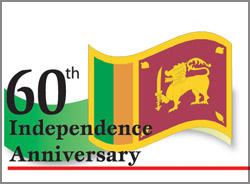
The national flag in legend and
history
The
National Flag that will be hoisted at the Independence Day celebrations
tomorrow is not the flag that Prime Minister D.S. Senanayake hoisted on
February 4, 1948, the day we got independence from British rule.
|
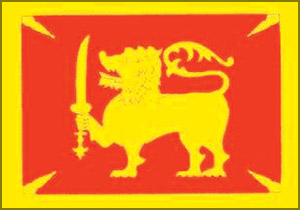
Flag of the Kandyan Kingdom used between 1469 and 1815 |
The flag Prime Minister Senanayake hoisted was the Lion Flag (Sinha
Kodiya), the Royal Standard of Sri Wickrama Rajasingha, the last king of
Kandy, and of Lanka. It has a golden lion holding a sword in its right
paw, on a maroon background, with a gold border and four stylised bo
leaves in the four corners.
After the first parliament was elected in August 1947, and D.S.
Senanayake was elected prime minister, the British Government informed
the Ceylon Government that the country would be granted independence,
that is the right to rule and conduct its own affairs.
Preparations began for the celebrations which were scheduled for
February 4, 1948. The Government was in a quandary. "What flag shall we
hoist on that day, when the Union Jack is lowered, marking the end of
British rule?" The British national flag is known as the Union Jack.
Since March 2, 1815 when the Kandyan Chiefs signed the convention
(agreement between the chiefs and the British Governor), the Union Jack
was the national flag of Ceylon, a colony of the British Empire.
I am sure you have been told or you have read that Wariyapola
Sumangala Thera, who was waiting in the crowd outside the Magul Maduwa
(audience hall) where the chiefs were assembled, pulled down the Union
Jack that was hoisted outside the Magul Maduwa.
Now, while this big question was troubling the Prime Minister and his
Cabinet, Mudaliyar A. Sinnelebbe, MP for Batticaloa, moved the following
motion in Parliament: "This house is of opinion that the Royal Standard
of Sri Wickrama Rajasinghe, depicting a yellow lion passant (walking)
holding a sword in the right paw, on a red background, which was taken
to England, should once again be adopted as the official flag of
Ceylon."
 I.E..
Goonesinha, Member of Parliament for Colombo Central, seconded the
motion and it was passed. Accordingly, it was agreed to hoist the Lion
Flag of Sri Wickrama Rajasinghe on Independence Day, 1948. I.E..
Goonesinha, Member of Parliament for Colombo Central, seconded the
motion and it was passed. Accordingly, it was agreed to hoist the Lion
Flag of Sri Wickrama Rajasinghe on Independence Day, 1948.
On that day, when after 133 years, the Lion Flag went up the flag
post on that historic site, where the Independence Hall now stands, in
the North (Jaffna) the Nandi Flag was hoisted in protest. The flag has
Nandi, the sacred cow in the centre.
The people of the north felt that the Lion Flag did not belong to
them, hence it could not be a national flag.
So, a committee was appointed to go into this question. This National
Flag Committee comprised S.W.R.D. Bandaranaike, John Kotalawela, J.R.
Jayewardene, T.B. Jayah, G.G. Ponnambalam, S. Nadesan, all MPs and Dr.
Senarath Paranavitane, Archaeological Commissioner who was appointed
Secretary of the Commission.
After two years, the committee presented its recommendation on
February 13, 1950. The National Flag that we use now is, as recommended
by that committee. "A lion in gold on a crimson background.
Four Bo leaves at the corners, two vertical stripes of equal size in
saffron and green to represent the minority communities, Tamils and
Muslims. A gold border runs round the flag." The 1978 Constitution also
declares that the National Flag of the Republic shall be the Lion flag.
Our Lion Flag has had an interesting history. It was taken away to
England soon after the convention of 1815. No one knew what happened to
it and no one seemed interested, until the end of that century or the
beginning of the 20th century, when national feelings were awakening.
|
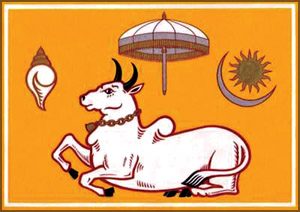
The Nandi flag of Jaffna. |
You may have heard of E.W. Perera. He was truly a great national
leader. He was called Lion of Kotte and his home in Kotte is now a
museum. It was this same E.W. Perera who took a petition to the
Secretary of State for Colonies, hidden in his shoe in 1915.
When he was a student in London in 1908, he read in a book on Ceylon
that the flag of the last king of Kandy was deposited in a museum in
Whitehall (Whitehall is that part of London where the Government offices
are). But it was not there.
Then someone else gave a tip that, it was in the Chelsea hospital.
E.W. Perera visited the place and to his surprise, found not one flag,
but three. They were hanging in the great hall along with other banners
and the Eagle of Napolean.
Says E.W. Perera: "They were hopelessly faded, the third could only
be recognised after being renovated. Two were clearly representations of
the Royal banner and the other probably the banner of the Atapattu 'Lekam.'
E.W. Perera sketched the flags from the key-plate. The Royal Flag was
copied in colour shortly after by Messrs Southwood and Co of Regent
Street, London for D.R. Wijewardene, who was also a student then in
London.
E.W. Perera describes his search for and discovery of the flag in the
book Sinhala Flags, Banners and Standards he compiled and which the
Colombo Museum published in 1916.
The lion has a special place in our history and our heritage. There
is a legend that Vijaya, banished from his native land, came by sea and
landed at Tambapanni, in the northwest of our island, and immediately
planted a flag on the beach.
In the stone archway at Sanchi in north-west India, built by King
Asoka, there is a carving of Prince Vijaya landing in Lanka, one of his
companions is carrying a flag. It is not certain whether the flag has
the figure of a lion. If it does, then, our Lion flag (Sinha Kodiya) is
the oldest national flag on record.
This quotation is from E.W. Perera's book: "The three lions on the
gateway of Sanchi have been identified as the royal arms of Ceylon, as
the peacock on it signifies the banner of the Maury dynasty.
The arch contains a representation of the dispatch of the Bo-tree to
Ceylon and the symbols on either side of the panel depict the Standards
(royal flag) of Asoka and the Sinhala monarch Devanampiya Tissa.
"This is the first representation we have of the Sinhala Royal
Standard. The lion was the national symbol from the fabled origin of the
Sinhala monarch Vijaya, from the king of beasts. Even the Mahavihara,
the Buddhist monastery at Anuradhapura, was laid out in the shape of a
lion."
The flag of the kings of Jayawardenapura, Kotte, had a lion. One of
the poems written during the period, the Perakumba Sirita describes the
flag with the lion, fluttering on the northern ramparts. The Dambulla
vihara built by King Keerthi Sri Rajasingha, (1747-82), centuries after
King Dutugemunu, preserves an old tradition.
One fresco shows the fight between Dutugemunu and Elara. Both (or
their elephants) are carrying their respective standards, Dutugemunu's
flag has a lion and the sun and moon symbols.
E.W. Perera states further in his book that a fragment of an ola
manuscript on flags he found in the library of the Malwatta Vihara,
records that a banner bearing the symbol of a lion holding a sword in
the right paw was the flag of Sri Wickrama Rajasingha.
A Belgian physician who visited Ceylon in 1687 describes the royal
standard carried in a military pageant held by the Dutch, in memory of
King Rajasingha II (1634-87). "It was a red lion on a gold field."
Our flag has seen many changes over the centuries. One record says
the royal flag had a red lion holding a sword in the right paw, on a
white field.
Whatever, the colour of the lion or the background, the lion has been
for over 20 centuries, the symbol on the flags of the kings of Lanka,
and now on the flag of the Republic of Sri Lanka.
Sumana Saparamadu
Six decades of freedom
A
historic day
marking a significant event will dawn tomorrow as the people of our land
unite to celebrate yet another Independence Day.
Six decades have
passed since our motherland was finally freed from hundreds of years of
foreign rule. It didn't come about without a struggle, but there was
very little blood shed when compared to many other countries that had to
virtually turn to violence to become independent countries.
The British who
ruled our country at that time certainly didn't give us the right to
rule our motherland on a platter. Our forefathers had to struggle for
this freedom we enjoy and boast of today.
|

Opening ceremony |
As we prepare to
mark the 60th Independence Day Anniversary of our motherland tomorrow,
let's refresh our minds today with the many events that led up to this
D-day and also the valiant roles played by many important people from
all communities to make this freedom a reality.
It is indeed
heartening to note that sixty years ago, the Sinhalese, Tamils and
Burghers Muslims all struggled as one and spoke with one voice to free
Mother Lanka from foreign rule.
But alas! Today
this unity is no more; there's an ethnic war to divide the country that
we all once struggled to free, together. There's animosity between the
very communities that once stood united to gain independence.
Let's hope that
when we celebrate Independence Day tomorrow, we could put our ethnic
differences aside and rise as one nation to usher in a peaceful and
prosperous era for our motherland, like the patriots of the past era.
As you are the
next generation that will inherit this land, take this opportunity to
extend a hand of friendship to all communities and think as Sri Lankans,
not as Sinhalese, Tamils, Muslims or Burghers, to develop our beloved
country.
****
Foreign rule
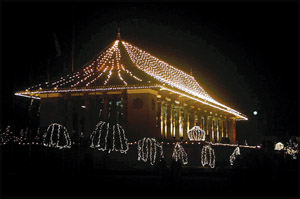 *
Our motherland came under foreign rule with the invasion by the
Portuguese in 1505. The first Portuguese fleet that arrived in our land
was led by Lorenzo de Almeida. *
Our motherland came under foreign rule with the invasion by the
Portuguese in 1505. The first Portuguese fleet that arrived in our land
was led by Lorenzo de Almeida.
* The Dutch who arrived in our shores to conquer Ceylon then
overthrew the Portuguese in 1658 after a six-month seige.
* The Dutch were eventually driven away by the British in 1796. They
then controlled the maritime provinces for 19 years.
* The British invaded the Kandyan Kingdom on February 1815.
* British Imperial rule prevailed in this country for no less than
150 years.
Kandy - the last bastian to fall
* The last Sinhala King to rule Sri Lanka (then known as Ceylon) was
Sri Vira Parakrama Narendrasinha (1706-1739). He was popularly known as
Kundasale Rajjuruwo (King of Kundasale).
* The Kandyan Kingdom was ruled thereafter for 76 years by Malabar
Kings from South India who were Hindus.
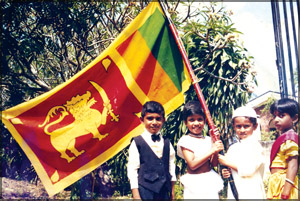 *
Sri Wickrama Rajasinghe was the last King to rule the Kandyan kingdom
before it came under British rule, ending 2,357 years of local rule. The
King was taken prisoner and deported to Vellore, South India. *
Sri Wickrama Rajasinghe was the last King to rule the Kandyan kingdom
before it came under British rule, ending 2,357 years of local rule. The
King was taken prisoner and deported to Vellore, South India.
* The King died in 1832
Governance (Pre - Independence)
* The first British Governor appointed to Ceylon was Frederick North
(later Earl of Guildford).
* Ceylon became a colony of the British Empire in 1815 and remained
so until February 4, 1948.
***
Road to freedom
* One of the earliest struggles against the colonial powers was the
1818 Uva-Wellassa rebellion. It was following this. Rebellion which was
crushed by the then British Governor Brownrigg that Keppetipola
Monarawilla was beheaded. Today he is a national hero.
* In 1848, hundred years before we finally gained independence,
another rebellion took place in Kandy. Its leaders Puran Appu and
Gongalegoda Banda were captured by the British who shot and killed them,
making them heroes of our motherland today.
* There were many others who continued this struggle for freedom over
the years. Some of these patriots were: D. S. Senanayake, F. R.
Senanayake, Ponnambalam Arunachalam, D. B. Jayatilleke, Ponnambalam
Ramanathan, Al Haj T. B. Jayah, Razik Fareed, G. G. Ponnambalam, S. W.
R. D. Bandaranaike, Anagarika Dharmapala, Migettuwatte Gunananda Thera,
Hikkaduwe Sri Sumangala Thera, Arthur V. Dias, D. R. Wijewardene, E. W.
Perera, James Peiries, W. A. Silva, Colvin R. de Silva and Sir Muthu
Coomaraswamy.
****
First Cabinet
* D. S. Senanayake was invited to form a Cabinet after the first
parliamentary elections in Ceylon held from August 15 to September 20,
1947.
* Of all the British colonies, Sri Lanka was the first country to get
voting rights.
* The first Cabinet was sworn in on February 4, 1948.
The Prime Minister, Minister of Defence and External Affairs was D.
S. Senanayake, Dudely Senanayake was the Minister of Agriculture and
Lands, while S. W. R. D. Bandaranaike became the Minister of Health and
Local Government. J. R. Jayewardene was the Minister of Finance.
The other Cabinet members were: G. E. de Silva, Sir Oliver
Goonetilleke, (E. A. P. Wijeratne took over his portfolio in July), R.
S. S. Gunawardene, T. B. Jayah, Col. J. L. Kotelawala, E. A. Nugawela,
Dr. L. A. Rajapakse, K. C. A. Ratnayake, C. Sittampalam and C.
Sundaralingam.
****
Independence Square
|
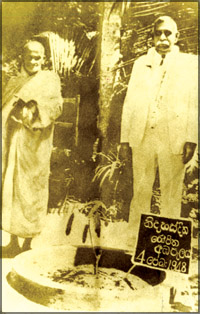
First Prime Minister D.S.Senanayake on this historic day seen at
a tea planting ceremony. |
|
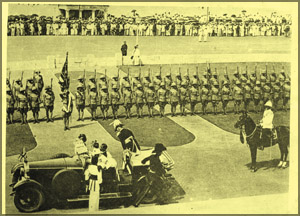
Arrival of Governor - General Sir Henry Monck Mason Moor to
inaugarate the First Parliament of Dominion Ceylon. |
Located at Torrington Place, Colombo 7, it has become the main venue
for Independence Day Celebrations for many years.
However, the first ceremony attended by the Duke of Gloucester,
(representing his brother King George VI of England) was held at this
site with the national flag being hoisted for the first time, in an
improvised pavilion as the present structure was constructed only after
that to commemmorate the event.
Today it has also become the venue of many national events and also
the cremation site for many important people. The first Prime Minister
D. S. Senanayake is also buried here.
First Independence Day
* Under the Independence Act, February 4, 1948 was referred to as the
'Appointed Day.'
* First day of freedom was declared a public holiday with
celebrations continuing until the opening of the Dominion Parliament on
February 10.
* With the booming of salutary guns at 7.45 a.m. on February 4, 1948,
the country's new status, the Dominion Ceylon, was announced.
****
Father of the Nation
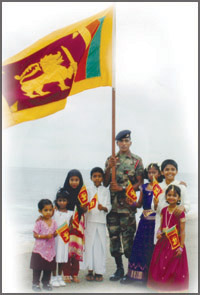 D.S.
Senanayake D.S.
Senanayake
* Don Stephen Senanayake was the first Prime Minister of Independent
Sri Lanka (Ceylon).
* Was born on October 20, 1884 in Botale, Meerigama.
* Studied at S. Thomas College, Mount Lavinia.
* Entered public life by associating with the Temperance Movement,
which wasn't held in favour by the British government.
* Was responsible for building many tanks for agriculture and also
contributed to the promotion of national literature.
* Died in 1952. |

